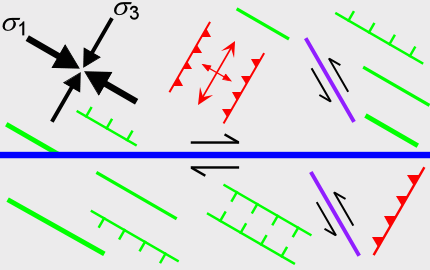Localized fracturing during wrench faulting
Contents IntroductionWrench fault bends Stress regimes at fault bends Secondary structures
|
Introduction |
This page discusses some aspects of
fracturing during regional faulting, with emphasis on wrench faulting.
This section will be expanded substantially.
Background. This section assumes that you have read the
introduction to Section 1.3
and are familiar with:
|
| ||||
Wrench fault bends | |
|
Like any fault, wrench faults can develop bends in a variety of ways:
|

|
Convergent bends develop systems of thrust faults that thicken the rock column while extensional bends develop systems of normal faults that thin the rock column. Analyzing fracture development at wrench-fault bends therefore involves the same types of analysis that are required in normal faulting and thrust faulting environments. The section of the right-lateral San Andreas fault between Los Angeles and the northern end of the Gulf of California provides a classic example of extensional and convergent deformation at adjacent bends on a wrench fault. The Transverse Ranges north of San Diego are mountains developed by thrusting at the convergent northern bend, while the Salton Trough is a basin developed at the extensional bend at the southern end. |
Stress regimes at fault bends | |
During wrench faulting, s1 and s3 (sigma-1 & sigma-2, the maximum and minimum compressive stresses) are horizontal and s2 (sigma-2, the intermediate compressive stress) is vertical. In general, the vertical stress at a point in the earth is equal to the weight of the overlying column of rock and, in most cases, the vertical stress is one of the principal stresses. Thrusting develops at a convergent wrench fault bend when lateral expansion of the rock in response to convergence increases s3 (which is horizontal in a wrench-faulting regime) until it exceeds the vertical stress, in other words, when the vertical stress becomes s3. Similarly, normal faults develop at extensional bends when lateral expansion due to extension decreases both horizontal stresses until the weight of the rocks becomes the maximum stress, in other words, when the vertical stress becomes s1. |
Secondary structures | |
|
Structures characteristic of other faulting regimes can develop during any type of faulting event, so this paragraph can be read as a general comment on secondary structures that commonly develop even when one type of deformation clearly dominates a terrane. Figure 2 shows a schematic view of an area undergoing wrench faulting. The figure depicts the case of a strong fault. In other words, when the fault is sufficiently strong that it can support a shear stress that is equal or nearly equal to the regional stress away from the fault. Although an inactive fault may be strong, research indicates that active faults, such as the San Andreas fault in California, are probably weak and cannot support large shear stresses. Secondary structures such as normal faults, folds, thrust faults, and joints can form throughout the area when the local stress regime changes similarly to the way it changes at extensional and restraining fault bends. Such changes may result from one or more of the following (and other) mechanisms:
Antithetic faults are simply conjugates to the main faults. Any stress regime favors two conjugate fault orientations equally, although one orientation is always better developed. One fault set develops in preference to its conjugate because of regional strain considerations/room problems. |
Figure 2 - Schematic map view of wrench faulted area indicating the type and orientation of secondary structures that will develop if the friction is so high along the fault that the regional stress field is not affected significantly by fault slip, which is unrealistic in many or most cases.

Figure 2 - Legend.

CONTENTS
| TO BE CONTINUED.... |
Copyright © 2000 - 2017-2002 • Alfred Lacazette • All Rights Reserved